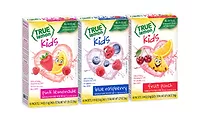A True Alternative
A True Alternative
By JENNIFER KOROLISHIN
Consumer desire for healthier choices, different
tastes drives alternative beverage segment
While it includes a wide
variety of products, the alternative beverage segment is most clearly
defined by what it’s not — namely, the usual carbonated soft
drink fare.
“When we first started, alternative beverages
were those that served as an alternative to carbonated soft drinks, and
that’s still the segment’s biggest makeup,” says Francie
Patton, vice president of marketing for Arizona Beverages, maker of the
Arizona Iced Teas, Arizona Infused Waters and Rx Herbal Tonic brands.
Alternative beverages typically contain functional
ingredients or have some nutritional value, and many favor organic
ingredients and are formulated without preservatives or artificial colors
or flavors. Carbonated juices, flavored waters and various juice, coffee
and tea-based drinks fall into the alternative segment.
“The alternative beverage segment encompasses
what’s commonly referred as ‘new age’ beverages —
functional beverages made with ingredients such as vitamins or ginseng, and
generally non-carbonated,” says Fuze Beverage LLC Founder and Chief
Executive Officer Lance Collins. Fuze’s alternative beverage lines
include the non-carbonated Energize, Slenderize, Refresh and Essentials
beverages, as well as Speedo Sportswater.
Because of the segment’s diversity, it’s
difficult to pinpoint its size or sales. Data from Information Resources
Inc., for the 52 weeks ending April 17, 2005, provides a snapshot of some
of the subcategories that comprise the alternative segment. The
shelf-stable bottled sparkling juice and refrigerated “all other
fruit juice” segments have current dollar sales of $64.9 million (a
5.4 percent increase) and $68.1 million (a 105.2 percent increase),
respectively. Shelf stable bottled lemonades are up 9.8 percent vs. a year
ago, with current sales of $142 million and a
7.5 percent increase in unit sales. Meanwhile, refrigerated ready-to-drink
coffee drinks are down 55.5 percent vs. a year ago, with current sales of
$4.5 million.
The alternative consumer
Baby boomers are driving much of the alternative
beverage segment as they strive to stave off the effects of aging by opting
for healthier beverage choices. However, as the alternative market grows,
it appeals to a wider range of consumers.
“We see tremendous growth in people looking for
alternatives,” says Seth Goldman, president and “TeaEO”
of Honest Tea, an organic bottled tea company that recently launched a line
of citrus quenchers called Honest Ade, sweetened with natural organic cane
sugar rather than high fructose corn syrup. “After decades of the
same choices, there is a sense that people are interested in something new.
But also, there’s really strong and growing interest in health and
you can see that across all segments of the food industry.”
At Fuze, that population is known as the “modern consumer.” “The modern consumer is age 25
and up, Generation Y-ers and Baby Boomers that have a lot of disposable
income,” Collins says. “They really care about what they
drink and eat and are very mindful of healthy ingredients. They read what
they drink — the ingredients, sugar content and carbohydrate
content.”
Alternative trends
Consumers’ quest for health drives the
alternative beverage segment in a number of ways, since what constitutes a
healthy choice has different meanings. For some, it may entail cutting
sugar consumption or increasing vitamin intake, while for others, it may
involve consuming more organic foods. Organic products like Honest
Tea’s are experiencing a boost from the three-year-old USDA Organic
symbol, which sets parameters for what beverages and foods can be labeled
as organic.
“Both health and organics are growing together
in the same way,” Goldman says. “Two years ago, we would have
all been touting low-carb, and that has clearly spiked and is now sinking.
But what isn’t going down is this trend of people looking at labels
and thinking about what they’re putting in their bodies.”
Using natural sweeteners is another aspect of
alternative beverages’ appeal. While most traditional carbonated soft
drinks use high fructose corn syrup, many alternative beverages opt instead
for ingredients such as crystalline fructose, a derivative of fruit sugar
used by Fuze. The companies that choose alternative sweeteners are banking
on the interest from dieters and those with certain health concerns.
Of course, while alternative beverage consumers may be
choosier about what they drink, they’re still interested in good
taste. “Exotic flavors are hot. I think if the taste is completely
different, it’s going to resonate with the modern consumer.
That’s what we focus our time and energy on,” Collins says.
There are also some packaging trends among alternative
beverages. Because they are usually produced in smaller quantities, many
are packaged uniquely using more complex printing and labeling techniques;
this also serves as a differentiator, given the range of products with
which alternatives are competing.
Arizona, known for its colorful, Southwestern-themed
packaging, is seeing its business move beyond single-serve cans and bottles
toward gallon containers, which are growing at about 30 percent a year.
“Our two best-selling packages are gallons and
the 23.5-ounce cans,” Patton says. “Our bottle business is
still healthy, but people like those take-home packages.”
Fuze, Honest Tea and Arizona report strong and growing
sales. “As long as you bring consumers new and exciting products,
they’ll continue to grow,” Patton says.
The fact that many alternative beverages are produced
by smaller companies that can make adjustments based on consumer demand
positions the segment to compete against other beverages.
“What’s great about Fuze is we’re
small enough to listen and monitor those trends, yet we’re large
enough to react,” Collins says. “We embrace the changing pace
of the market — we call it ‘survival of the
tastiest.’” BI
Looking for a reprint of this article?
From high-res PDFs to custom plaques, order your copy today!




